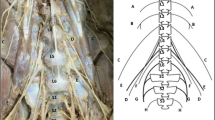Abstract
Basis
Deviations detected during spinal operations have motivated us to start research related to variations of lumbosacral plexus formation. Aim of this work was to find out deviations of its formation from ascension of particular roots from foramen invertebrale and foramina sacralia up to formation of terminal branches.
Set
One hundred lumbosacral plexi have been examined in 50 adult cadavers for a purpose to find out an incidence of neural variations. We have observed participation of Th12 root, L4 and L5 roots in its formation, as well as various deviations from ascension of particular plexiform roots up to their ending branches. For lumbal plexus, we have observed four nerve roots and six lumbal nerves; for sacral one, three sacral roots with a share of S4 and lumbosacral trunk formed of L4 and L5 roots and four sacral nerves. We have considered also their course, anastomoses and thickness. We highlight motoric innervation particularities in relation to diagnostics besides anatomical complexity and variability.
Results
Variations on the level of neural roots were common, nerve formations were uncommon. Thickness of neural roots, formation or their absence were dependent on the type of plexus, particularly in sacral area. For lumbal plexus, L1 root was the thinnest and L4 root was the thickest. L3 root was the thickest in six cases. Fifth lumbal root usually completely filled foramen invertebrale. We have observed double ascension of L4 root from foramen invertebrale in 25 cases and plexiform in five cases. In other cases it was branched in various distance following ascension from foramen invertebrale. Plexiform ascension of L3 root along with L4 root was present in two cases. Double ascension of L3 root was present in four cases. L2, L3 along with L5 roots were doubled in two cases. Iliohypogastric nerve was the longest, ilioinguinal was the thinnest and nervus femoralis was the thickest. Changes in sacral plexus on the level of neural roots have been observed 41-times. Double ascension of L5 root was present in eight cases and plexiform in four cases. Double S1 root at ascension from foramina sacralia was present 16 times, S2 8 times, S3 once and S1 along with S2 4 times. S1, S2 and S3 roots were branched in various distance following ascension from foramina sacralia in 15 cases. Truncus lumbosacralis was thickened in 19 cases, a share from L4 root was thicker as L5 root in 11 cases. Low level of connection between truncus lumbosacralis and S1 root was observed in 10 cases. Nervus ischiadicus has branched into tibial and peroneal portions already in minor pelvis in two cases. The level of distance of n. (nervus) gluteus superior, n. gluteus inferior, n. cutaneus femoris posterior and n. pudendus was dependent on the plexus type.
Conclusion
This study enabled us to find out and to describe extraordinary anatomical deviations in formation of neural roots and nerves of lumbal and sacral plexus, undescribed yet.








Similar content being viewed by others
References
Williams PL, Bannister LH, Berry MM, Collins P, Dyson M, Dussek JE, Fergusson MWJ (1995) Gray’s anatomy, 38th edn. Churchill Livingstone, London, pp 1258–1274
Williams PL, Warwick R (1985) Gray’s anatomy, 36th edn. Churchill Livingstone, London, pp 1106–1110
Chin Ch, Chew KC (1997) Lumbosacral nerve root avulsion. Injury 28:674–678
Erbil K, Onderoglu S, Basar R (1998) Unusual branching in lumbar plexus. Case report. Folia Morphol (Warsz) 57:377–381
Hope EE, Bodensteiner JB, Thong N (1985) Neonatal lumbar plexus injury. Arch Neurol 42:94–95
Iczi Y, Gürkanlar D, Ozan H, Gönül E (2005) The morphological aspects of lumbar plexus and roots. An anatomical study. Turk Neurosurg 15:87–92
Urbanowitz Z (1981) Connections between the lumbal and sacral plexus in man. Folia Morphol (Warsz) 40:271–279
Weber RH (1961) Some variations in the lumbal plexus of nerves in man. Acta Anat 44:336–345
Bergman RA, Thompson SA, Afifi AK, Saddeh FA (1988) Compendium of human anatomical variations. Urban and Schwarzenburg, Baltimore, pp 138–139
Haigh PI (1999) Soft-tissue images. Abdominal aortic aneurism causing lumbar plexus neuropraxis. Can J Surg 42:329
Marieb EN, Mallat J (2005) Základy embryologie, kapitola 3. In: Marieb EN, Mallat J (eds) Anatomie lidského těla. Computer Press, a.s., Brno, pp 62–67
O’Rahilly R, Muller F, Meyer DB (1990) The human vertebral column at the end of the embryonic periods proper. 4. The sacrococcygeal region. J Anat 168:95–111
Author information
Authors and Affiliations
Corresponding author
Rights and permissions
About this article
Cite this article
Matejčík, V. Anatomical variations of lumbosacral plexus. Surg Radiol Anat 32, 409–414 (2010). https://doi.org/10.1007/s00276-009-0546-3
Received:
Accepted:
Published:
Issue Date:
DOI: https://doi.org/10.1007/s00276-009-0546-3




